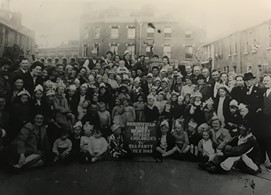During the 1300’s, strong thirsts for power between countries, religious divisions in Europe, and competition for trade routes were common. Trade routes connected the Eastern Hemisphere with the trade of various goods and information, and controlling these trade routes proved to be rewarding. Unfortunately, these trades routes “also likely carried the deadly plague that killed as many as half of all Europeans within seven years, in what is known as the Bubonic Plague.”1
Beginning in 1348, Bubonic Plague infested merchant ships sailing from the Black Sea to Mediterranean ports, causing so much death that it was common for ships to enter European docks and harbors with at least the majority of the crew dead. Despite efforts to prevent ships from reaching land and spreading the disease, the Bubonic Plague made its way ashore. Unfortunately, people found out how contagious the Bubonic Plague was as it swept through Sicily, Italy, and into the rest of Europe. As a result of the virtual inability of people to stop the spread, many suffered and died.

At the height of the Bubonic Plague, it had spread from China to London, devastating entire villages and bringing trade to a virtual standstill. It has been estimated that as many as 200 million people lost their lives as a result of the Bubonic Plague. In fact, it had a mortality rate that varied between regions.2 Although the Black Death was responsible for killing millions of people in Europe, it was a strong force in influencing the structure of power in the Eastern Hemisphere.
Marchione di Coppo Stephani, a chronicler who lived through the ravages of the plague in Florence during the summer of 1348 wrote,
At every church they dug deep pits down to the water level; and thus those who were poor who died during the night were bundled up quickly and thrown into the pit; they then took some earth and shoveled it down on top of them; and later others were placed on top of them and then another layer of earth, just as one makes lasagna with layers of pasta and cheese.3
It not only underlines the crisis for a major European city, generated by the death of tens of thousands of people, but also demonstrates how, even in recording such a profound crisis, a chronicler might evoke a homely, if provocative, image of lasagna.4 People believed that the world was coming to an end. Who was to blame? Other religions, or was it God punishing people for their sins?
As a result of much death and destruction on a scale that people have never seen before, people began wondering if God had been punishing them all along. There was no safe haven for people, even in isolated Russia, for the Black Plague did not hesitate to take any lives—every one was a target.
In the same year [1346], God’s punishment struck the people in the eastern lands, in the town Ornach [on the estuary of the River Don], and in Khastorokan, and in Sarai, and in Bezdezh [at an arm of the River Volga], and in other towns in those lands; the mortality was great among the Bessermens, and among the Tartars, and among the Armenians and the Abkhazians, and among the Jews, and among the European foreigners, and among the Circassians, and among all who lived there, so that they could not bury them [sic]. 5
In fact, religious hatred and persecution was very inhumane and common. With the strong belief that other groups were responsible for the Plague, the methods involved in persecuting other religious groups were cruel. Some common examples were: burning, stoning, decapitation, and exile.
The Black Death was devastating. It had killed millions of people across Europe and Asia. Anarchy, fear, and insecurities dominated the landscape in Europe during the 1300’s.[ 5. Sharon N. DeWitte, “Age Patterns of Mortality During the Black Death in London, A.D. 1349–1350,” Journal of Archaeological Science 37, no. 12 (December 1, 2010): 3394-3400, https://www.ncbi.nlm.nih.gov/pmc/articles/PMC3094018/ (accessed October 12, 2016).]
- Andrew Lawler, “How Europe Exported the Black Death,” Science 352, no. 6285 (April 29, 2016): 501–2. ↵
- Encyclopedia Britannica, February 2015, s.v. “Black Death.” ↵
- Marchione Di Coppo Stefani, “The Florentine Chronicle,” 1903-1913, accessed, October 18, 2016. http://www2.iath.virginia.edu/osheim/marchione.html. ↵
- John Henderson, “Debating Death and Disease,” History Today 64, no. 4 (April 2014): 58–59. ↵
- Celestine Bohlen, “Diphtheria Epidemic Sweeps Russia,” The New York Times, January 29, 1993, sec. World, http://www.nytimes.com/1993/01/29/world/diphtheria-epidemic-sweeps-russia.html. ↵



76 comments
Carlos Hinojosa
I think what people tend to forget about the Bubonic Plague or the Black death is that it happened everywhere in the world. It hit Asia, middle east and even Africa. It’s just the only reason why we only mention Europe is because, well one is that is where most history based and two that it caused the most devastation there. Anyways, I think this article did an amazing job at describing the toll the Plague had on Europe and how much devastation it did in only 7 years.
Amanda Gutierrez
Very nice article! I actually watched a YouTube video today on the Black Plague. Just imagining the smell and sight of dead bodies everywhere gives me an eerie feeling. It saddened me when reading about the discrimination towards other religion groups that formed during the times of the plague. However, Europe and Asia were resilient as they survived the sickness and became stronger in the end. Overall, this was a well-written and informative article. Good job!
Angela Calderon
The Bubonic Plague had such devastating effects on the Eastern Hemisphere–considering it decimated about 50% of the world’s population of approximately 400 million at that time–that one can only wonder how the plague would have affected the Western Hemisphere. Even without a prevalent pandemic, western colonization caused the deaths of many American Natives due to illnesses brought from the East. That said, Bubonic Plague in the West would have had even more devastating effects on the world’s population.
In reading this article, I found it interesting to see that “hatred and persecution” is prevalent in just about any pandemic, even today. Most recently, the COVID-19 pandemic has caused the ostracization of Asian people, due to its origins in the East. Before that, the Ebola outbreak led to increase in Black discrimination. Before that, the AIDS pandemic encouraged a rise in homophobia. There seems to be a very clear link between fear and hatred.
Meadow Arriaga
The Black Plague was a historical event I covered in high school. I would compare those days to now, and I believed humans have developed to survive situations like these. The Black Plague changed history and caused mass destruction beyond lowered population in Europe. People believed it was a form of punishment from God. This led to further punishments to those infected, and minimal survival.
Mauro Bustamante
This article was really informing and well written, it describes that the Bubonic Plague infested merchant ships sailing from the Black Sea to Mediterranean ports, causing so much death that it was common for ships to enter European docks and harbors with at least the majority of the crew dead. Many people during that time really thought the world was coming to an end because of the numerous deaths that occurred. it was a tragic time period but Despite the sickness killing millions of people of Europe and Asia, the countries still survived and formed a new era better and stronger than ever. This topic I went over in one of my classes and it was really a tragic time in history.
Amelia Hew
I’ve read about the black plague back in Highschool and I can’t imagine what life was like back then, bodies buried on top of bodies with just a layer of soil separating them from each other with many more deaths continuing to occur. It’s disappointing to know that they put the blame of the sickness on other religion groups and punish them where this situation is totally out of their control. Despite the sickness killing millions of people of Europe and Asia, the countries still survived and formed a new era better and stronger than ever.
Kristina Tijerina
It’s unfortunate that people couldn’t find the cause of the Black Plague during this time and resorted to burning, stoning, decapitation, and exile of people of different religions because they believed they were being punished by God. The Black Plague was a horrid disease that everyone feared because of its ability to kill many people quickly and harshly. They couldn’t prevent it from spreading and millions of people were victims of this disease. It’s really unfortunate to hear about the deaths of these people, but it’s even worse to know that many of them were wrapped and thrown into the ground because they were poor. They were all layered upon one another in their makeshift grave like “lasagna,” as stated above.
Angely Noriega Baron
Unfortunately, no one was quite sure how the Black Plague was spreading and a lot of people chose to avoid others with symptoms. In the article, it states how people thought that the world was coming to an end and I remember reading an article that said that people built pestilence houses, where the sick would be able to go to and die because they were so afraid for that to be true.
Liam Morrison
Sadly for the people in the 1300s, they were totally unaware they were carrying this disease that would kill so many people. I think the worst thing about this disease was knowing you could not do anything about it. Luckily for us it is no longer around and hopefully a disease like this never happens again. Finally, I thought this article was very interesting and an overall great read.
Elizabeth Guardiola
I have alway had a general understanding of the Black Plague, but it is enlightening to become familiar with its affect on communities beyond its deadliness. It is disheartening to see how many people suffered during this time, the visual comparison to a lasagna created a horrific image and magnified the intensity of the situation. However, beyond death, the Black Plague pulled apart communities and caused chaos among them. As different religious groups began to pit themselves against one another, more and more people died not by defeat from the plague, but at the hands of their neighbor which is truly sad.